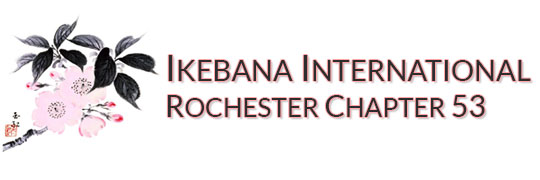Ichiyo Ikebana Exhibition, Webster, NY.

Ms. Karen Napoli–the president of the Rochester branch of the Ichiyo School of Ikebana–orchestrated an exhibition at the Webster, NY public library. She had most of her present students contribute to the large number of arrangements placed in the library during the third full week of April. The pictures that follow are pictures of these arrangements.

There were many different types of arrangements at this library exhibition. Some were very simple, and some were more complex. Some were large and some were small. They all had something to offer to the viewer. This arrangement to the left is done like the one above it by Ms. Napoli. The top arrangement uses many baskets. These types of baskets are used very commonly in the Ichiyo School of Ikebana. As the ikebana student advances in their training, they are expected to be comfortable making arrangements with these types of baskets. The baskets may be round and flat, or they may be tubular and open at one end. But actually, any open and airy basket can be used. The arrangement to the left is light and airy. The lightness of the white container (suiban) with black speckling
is matched with the lightness and texture of the plant material. Many times viewers of ikebana try to “figure” out the arrangements or to “understand” them. The best way to engage them is simply to enjoy their beauty.
This next arrangement is one of the more “simple” arrangements. One triangular container (the white one) is put partially in the other (black one). And only two flowers are used. Making arrangements with very few materials can be very difficult. In larger arrangements, flaws in the arrangement can be hidden better than when there are only a few. In the smaller

arrangements, more attention has to be placed on everything used in the arrangement as their presence is prominent. More attention is placed on every item in smaller arrangements.

The arrangement next to this comment is another “simple” one. Some of these arrangements had associated poems which were linked to the type of arrangement seen.
For some viewers, the more simple designs are the most attractive. For others, the larger more complex arrangements are the one’s they favor. Which type of your favorite? This arrangement was made by one of Ms. Napoli’s newest students. Once someone has
taken lesson and has developed confidence in making arrangements, they move on to the more difficult ones. The principles learned in the earlier lessons is carried over to the latter ones.
This arrangement in the glass bowl has an added point of interest. The arrangement materials are broken up into two areas–one area is along the rim of the larger bowl, and the other is in the smaller bowl inverted in the larger bowl. As one changes in their viewing position, so does the appearance of the materials in the bottom of the container. The water can act like a magnifying glass depending on the position of the viewer.

The stems of the plants along the rim are short and hidden under the plant materials. In glass container arrangements in the Ichiyo School, what is in the water is just as important as what it out of the water. So in glass container arrangements there are practically two arrangements–one above and one below the water. Of course in this arrangement, the anthurium flower and leaf is supported by the water. In the above arrangement along the back rim, it is held in place by a support with short stems so as to not be visible to the viewer.

This arrangement is called the flowing form and I’m sure that the reader can tell why. It is one of the first arrangements that a beginning student learns to make. There are variations of this form. Typically, only three branch stems and three
flowers are used. It is the favorite of many students for its grace and flow. It has a very peaceful and calming effect.
In this arrangement made by another student of Ms. Napoli, who has a certificate to teach in the Ichiyo School of Ikebana, we see two elements of interest. One is the use of natural materials including the rocks besides the formal container. The second point is that this arrangement is called a compound arrangement as two arrangements are brought together to form one unified arrangement. In the Ichiyo

School one is only limited by their imagination as to what they can make. As a student develops in learning the basic principles discussed in the earlier lessons books, these principles are brought together in the later “freestyle” arrangements.

In this last arrangement we see the effect of “lifting.” The concept of “lifting” creates space which is important in ikebana arrangements. Many Western flower arrangements will present materials together in one whole mass with no space between the materials. Here in this arrangement we not only see space below the arrangement, but also space is seen between the various elements. This space opens up the arrangement and makes it “lighter.” We can also see a technique known as “grouping.” In “grouping” differrent materials are put into the arrangement as a group instead of individually, but in a way that creates a harmonious
whole. In the Ichiyo School of Ikebana there is an arrangement form known as the “group contrast” arrangement. In this arrangement form, a straight-line group is brought together with a curving line group. A floral group is also added to bring it all together. The arrangement we have here has the curving line element, as well as the solid green mass. The flowers are added to complete it.
Please keep in contact with this blog for future ikebana exhibitions and displays.
